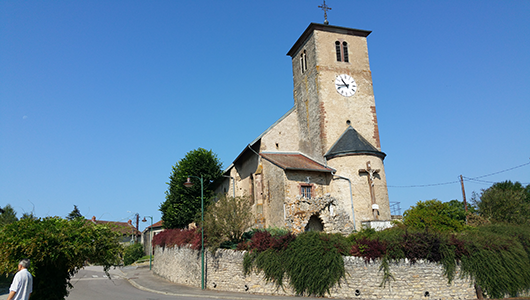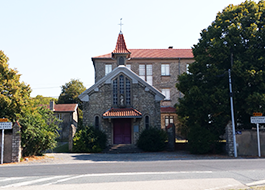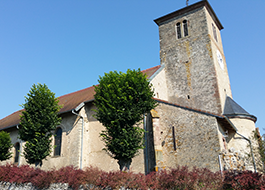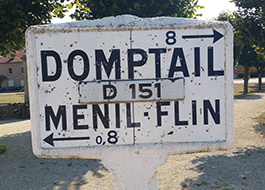Flin
Durée visite : 30 minutes
Moyen : Pédestre
La seigneurie appartint à la famille de Ficquelmont . Cette illustre lignée est attestée depuis le XIIe siècle. Elle a donné des chambellans au duc de Lorraine, un maître d’hôtel à Louis XIII, des officiers aux cours d’Espagne, de France, des Pays-Bas belges et d’Autriche. Ce dernier pays a eu comme général et ministre Charles de Ficquelmont au XIXe siècle. Cette famille s’est éteinte en 1991. Ses armes, loup passant sur trois pals, se retrouvent sur le blason du village. Celui-ci a été incendié pendant les guerres de Religion, la guerre de Trente Ans et en septembre 1944. C’est à croire qu’on lui en voulait. Il fut à chaque fois entièrement reconstruit.
The seigneury belonged to the Ficquelmont family. This illustrious lineage has been documented since the 12th century. She gave chamberlains to the Duke of Lorraine, a butler to Louis XIII, officers in the Spanish courts of France, the Belgian Netherlands and Austria. The latter country had as general and minister Charles de Ficquelmont in the 19th century. This family died out in 1991. Its arms can be found on the coat of arms of the village. It was set on fire during the Wars of Religion, the Thirty Years’ War and in September 1944. It is as if we were angry with him. It was each time completely rebuilt.
Das Seigneury gehörte der Familie Ficquelmont. Diese berühmte Linie wurde seit dem 12. Jahrhundert dokumentiert. Sie gab dem Herzog von Lothringen, einem Butler Ludwigs XIII., Beamten an den spanischen Gerichten Frankreichs, der belgischen Niederlande und Österreichs, Kammerherren. Das letztere Land hatte im 19. Jahrhundert als General und Minister Charles de Ficquelmont. Diese Familie starb 1991 aus. Ihre Waffen befinden sich auf dem Wappen des Dorfes. Es wurde während der Religionskriege, des Dreißigjährigen Krieges und im September 1944 in Brand gesteckt. Es ist, als wären wir wütend auf ihn. Es wurde jedes Mal komplett neu aufgebaut.

Ecartelé : au 1° de gueules à deux saumons d’argent , au 2° d’or à la bande de gueules chargée de trois alérions d’argent ; au 3° d’or à trois pals abaissés, au pied fiché de gueules, surmontés d’un loup passant de sable ; au 4° d’azur au chevron d’argent accompagné en chef de deux croix fleurdelisées d’or et en pointe d’un alérion de même.
Flin dépendait de la Prévôté de Deneuvre (les deux saumons) et du duc de Lorraine (la bande chargée des trois alérions). Les Ficquelmont (les pals) et les Rouot (le chevron) furent successivement seigneurs du lieu. C’est pour cela que l’on retrouve leurs blasons dans les quartiers 3 et 4 de l’écu communal.
Quarterly: 1 ° Gules with two silver salmon, 2 ° of gold a bend Gules charged with three alerions Argent; 3rd of gold with three lowered pals, at the foot stuck Gules, surmounted by a wolf passing Sable; 4th, azure, a chevron Argent, accompanied in chief by two fleurdelized crosses of gold and a point of an alérion of the same.
Flin depended on the Prévôté de Deneuvre (the two salmon) and the Duke of Lorraine (the band in charge of the three alerions). The Ficquelmont (the pals) and the Rouot (the chevron) were successively lords of the place. This is why their coats of arms can be found in quarters 3 and 4 of the communal ecu.
Vierteljährlich: 1 ° Gules mit zwei Silberlachsen, 2 ° aus Gold eine Biegung Gules mit drei Alerionen Argent aufgeladen; 3. aus Gold mit drei gesenkten Kumpels, am Fuß stecken Gules, überragt von einem Wolf, der an Sable vorbeikommt; Viertens azurblau, ein Chevron Argent, der hauptsächlich von zwei fleurdelisierten Goldkreuzen und einer Spitze eines Alérions desselben begleitet wird.
Flin war abhängig vom Prévôté de Deneuvre (die beiden Lachse) und dem Herzog von Lothringen (der für die drei Alerionen zuständigen Band). Die Ficquelmont (die Kumpels) und die Rouot (der Chevron) waren nacheinander Herren des Ortes. Deshalb befinden sich ihre Wappen in den Vierteln 3 und 4 des kommunalen Steuergeräts.

Les habitants de Flin s’appellent les Flinois et les Flinoises.
The inhabitants of Flin are called Flinois and Flinoises.
Die Einwohner von Flin heißen Flinois und Flinoises.
Les points de visites
.
Dans son premier état, la chapelle fut construite en 1921 pour remercier la Vierge de Mervaville d’avoir épargné le village de Flin en 1914. À côté, en 1938, un grand bâtiment fut inauguré pour accueillir un petit séminaire de la Société des Missions Étrangères. La chapelle fut agrandie. Le séminaire accueillit des élèves, jamais plus d’une quarantaine, jusqu’en 1966. Il connut ensuite diverses vicissitudes, mais une messe continua d’y être célébrée pendant de nombreuses années, le dimanche matin à l’intention des habitants. Aujourd’hui la chapelle appartient à la commune ; on y donne des concerts. Le reste des bâtiments du séminaire a été vendu une société de transports.
In its first state, the chapel was built in 1921 to thank the Virgin of Mervaville for having spared the village of Flin in 1914. Next to it, in 1938, a large building was inaugurated to accommodate a small seminary of the Société des Missions Étrangères . The chapel was enlarged. The seminary received students, never more than forty, until 1966. It then experienced various vicissitudes, but a mass continued to be celebrated there for many years, on Sunday mornings for the inhabitants. Today the chapel belongs to the municipality; we give concerts there. The rest of the seminary buildings were sold to a transport company.
In ihrem ersten Zustand wurde die Kapelle 1921 erbaut, um der Jungfrau von Mervaville dafür zu danken, dass sie 1914 das Dorf Flin verschont hatte. Daneben wurde 1938 ein großes Gebäude eingeweiht, in dem ein kleines Seminar der Société des Missions Étrangères untergebracht war . Die Kapelle wurde vergrößert. Das Seminar empfing bis 1966 nie mehr als vierzig Studenten. Es erlebte dann verschiedene Wechselfälle, aber dort wurde am Sonntagmorgen für die Einwohner noch viele Jahre lang eine Messe gefeiert. Heute gehört die Kapelle der Gemeinde; Wir geben dort Konzerte. Der Rest der Seminargebäude wurde an ein Transportunternehmen verkauft.
.
.
L’église Saint-Martin est de type grange. Le bas du clocher, l’abside et la porte murée côté Nord datent du XIIe siècle. Ils sont de style roman. Le chœur est gothique, la nef classique, la tribune date de la fin du XIXe. L’ancien cimetière s’étendait autour de l’église. De très belles fresques du XVe siècle sont à découvrir. L’église Saint Martin accueille des visiteurs le dimanche de 10h à 18h.
The Saint-Martin church is barn type. The bottom of the bell tower, the apse and the walled door on the north side date from the 12th century. They are in Romanesque style. The choir is Gothic, the nave classic, the gallery dates from the end of the 19th century. The old cemetery stretched around the church. Saint Martin’s Church welcomes visitors on Sundays from 10 a.m. to 6 p.m.
Die Saint-Martin-Kirche ist vom Typ Scheune. Der Boden des Glockenturms, die Apsis und die ummauerte Tür an der Nordseite stammen aus dem 12. Jahrhundert. Sie sind im romanischen Stil. Der Chor ist gotisch, der Kirchenschiffklassiker, die Galerie stammt aus dem Ende des 19. Jahrhunderts. Der alte Friedhof erstreckte sich um die Kirche. Die St.-Martins-Kirche begrüßt die Besucher sonntags von 10 bis 18 Uhr.
.
Les panneaux existent depuis l’époque romaine. Les premiers panneaux apparaissent en France à la fin du XIXe siècle, à l’initiative des personnes privées. Ce sont les précurseurs de la signalisation routière. En 1908, André Michelin décide d’utiliser les numéros des routes des cartes d’état-major. Il crée les premiers panneaux en plaque émaillée avec le nom des localités, les numéros de routes, des inscriptions de sécurité. De 1914 à 1918, ce sont 30 000 de ces plaques de différentes formes qui sont offertes, gratuitement, aux municipalités. Si les panneaux dans un premier temps gratuits, ce n’est pas sans raison. Sur les panneaux était écrit «Don de Michelin», c’étaient les premières publicités. En 1931, Michelin est homologué par l’État comme constructeur officiel de panneaux. Ensuite ce sont les commerçants et les communes qui ont payé. Dessus ou derrière les panneaux sont écrits la date de la pose et le nom des donateurs. En 1939, 70 000 panneaux sont en place au bord des routes françaises. Ce qui a pourtant fait la force de ces panneaux Michelin a aussi fait leur faiblesse. L’usage des voitures se démocratise; ces panneaux en béton armé deviennent trop dangereux pour la circulation, notamment sur les nouvelles autoroutes. En 1971, Michelin stoppe sa production; les panneaux sont peu à peu enlevés au gré des travaux routiers. Il en subsiste néanmoins un bon nombre, en raison d’une leur solidité à tout épreuve. Il faut savoir qu’il y a autant de béton armé en dessus qu’en dessous. Cela pèse près de 500 kg. Si les indications ne sont pas fausses et qu’elles ne représentent pas un danger, les communes les laissent en place. Elles font aujourd’hui le bonheur des collectionneurs.
The panels have been around since Roman times. The first panels appeared in France at the end of the 19th century and were initiated by private individuals. They are the precursors of road signs. In 1908, André Michelin decided to use the road numbers from the staff maps. He created the first enamelled plate signs with the names of localities, road numbers, safety inscriptions. From 1914 to 1918, 30,000 of these plaques in different shapes were offered free to municipalities. If the panels at first free, it is not without reason. On the panels was written « Don de Michelin », it was the first advertisements. In 1931, Michelin was approved by the State as an official panel manufacturer. Then it was the traders and the municipalities who paid. Above or behind the panels are written the date of installation and the name of the donors. In 1939, 70,000 signs were in place along French roads. However, what made the strength of these Michelin panels also made their weakness. The use of cars is becoming more democratic and these reinforced concrete panels are becoming too dangerous for traffic, especially on new highways. In 1971, Michelin stopped production and the panels were gradually removed as the road works began. However, there are still a good number of them due to their foolproof solidity. You should know that there is as much reinforced concrete above as below. It weighs almost 500 kg. If the indications are not false and that they do not represent a danger, the municipalities leave them in place. Today they are the delight of collectors.
Die Tafeln gibt es seit der Römerzeit. Die ersten Tafeln erschienen Ende des 19. Jahrhunderts in Frankreich und wurden von Privatpersonen initiiert. Sie sind die Vorläufer der Verkehrszeichen. 1908 beschloss André Michelin, die Straßennummern aus den Personalkarten zu verwenden. Er schuf die ersten emaillierten Schilder mit den Namen der Orte, Straßennummern und Sicherheitsinschriften. Von 1914 bis 1918 wurden 30.000 dieser Plaketten in verschiedenen Formen den Gemeinden kostenlos angeboten. Wenn die Paneele zunächst frei sind, ist dies nicht ohne Grund. Auf den Tafeln stand « Don de Michelin », es war die erste Werbung. 1931 wurde Michelin vom Staat als offizieller Plattenhersteller zugelassen. Dann zahlten die Händler und die Gemeinden. Über oder hinter den Tafeln sind das Installationsdatum und der Name der Spender angegeben. Im Jahr 1939 waren 70.000 Schilder entlang der französischen Straßen angebracht. Was jedoch die Stärke dieser Michelin-Paneele ausmachte, machte auch ihre Schwäche aus. Der Einsatz von Autos wird demokratischer und diese Stahlbetonplatten werden für den Verkehr zu gefährlich, insbesondere auf neuen Autobahnen. 1971 stellte Michelin die Produktion ein und die Paneele wurden nach und nach entfernt, als die Straßenarbeiten begannen. Es gibt jedoch immer noch eine gute Anzahl von ihnen aufgrund ihrer narrensicheren Solidität. Sie sollten wissen, dass oben und unten so viel Stahlbeton vorhanden ist. Es wiegt fast 500 kg. Wenn die Angaben nicht falsch sind und keine Gefahr darstellen, lassen die Gemeinden sie an Ort und Stelle. Heute sind sie die Freude der Sammler.








